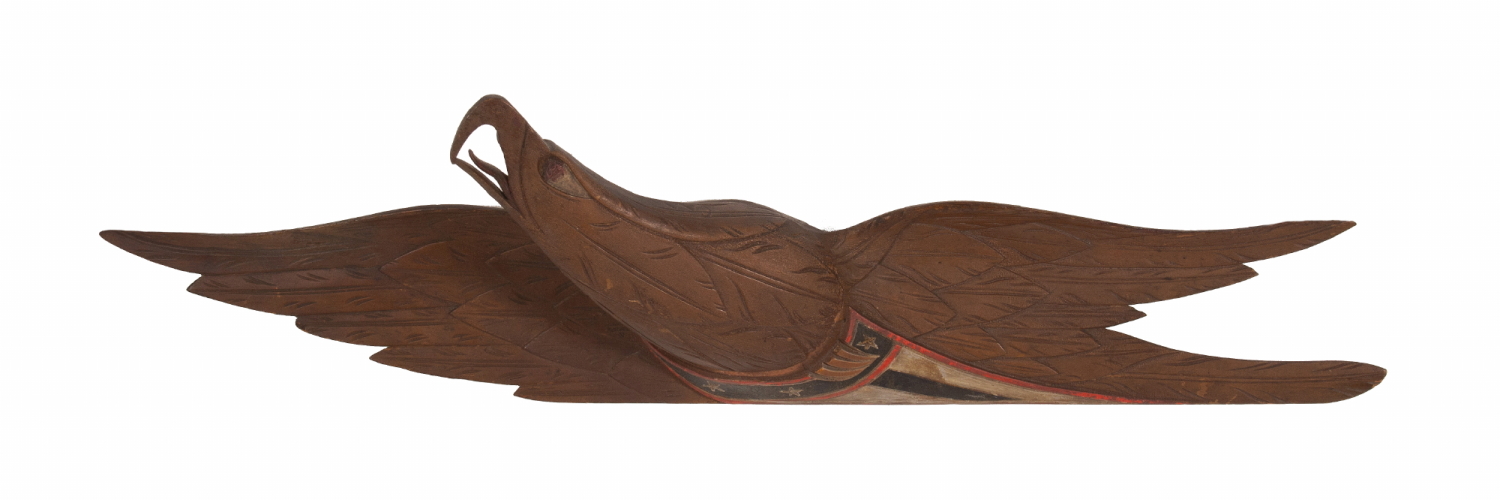
| |
CARVED EAGLE FROM THE SHOP OF JOHN HALEY BELLAMY, THE MOST RENOWNED CARVER OF THE FORM, w/ WONDERFUL, PUMPKIN BROWN / MUSTARD PAINT & EXCELLENT SURFACE, circa 1875-1890’s |
| |
|
| Dimensions (inches): |
4" tall x 24.5" long x 3.75" deep |
| Description: |
|
Carved wooden eagle, attributed to the shop of the most renowned, American, 19th century carver of the form, John Haley Bellamy (1836-1914). A prolific artisan and entrepreneur, who considered himself more the former than the latter, Bellamy was employed by the U.S. Navy as a Civilian, during the Civil War, serving as the leading carver at Charlestown Navy Yard, Boston. Post war he continued to work for the Navy, then opened a shop in Boston in a building that also housed a Masonic Hall. Here he made all sorts of things for a fraternal audience, as well as others. Eventually he left for New Hampshire. Renting bench space at first in Portsmouth and working alongside other carvers, before relocating to his own space at 17-18 Daniel Street.
Although Bellamy’s career as a carver began in his boyhood town of Kittery, Maine in the 1850’s, he appears to have carved his first two stand-alone eagles (meaning those not a part of something else) in the fall of 1872, when working in Portsmouth. One of these he produced as a commission for a man by the name of Oscar Leighton, who lived on the Isles of Shoals, an archipelago bridging the border between New Hampshire and Maine. The other he carved in order to have one on hand to sell. He then began producing others and selling them all over the greater Portsmouth area. He established production-line methods in order to turn out carvings in quantity. Smith describes them as being “like snowflakes in a storm, alike but different” (p. 37). By 1873, Bellamy had carved so many that, according to author Yvonne Brault Smith, he exclaimed, “If I stay here a short time longer [I] shall have them [eagles] over every door.” * (p. 21).
Many of Bellamy’s eagles are gilded. Some are painted white and various other colors, and some are natural wood. Most are decorated in red, white, and blue paint, sometimes including black. Many had streamers, often with patriotic text. Because his works were both commissioned and produced for open stock, anything was plausible. One of the largest and most memorable Bellamy eagles, perhaps 14-16 feet in length, adorned a fire hall in Portsmouth.
Diminutive in scale and delicate, this is one of Bellamy’s graceful, elongated forms. It is also one of his smallest, at 24.5” in length. Carvings of this sort, intended for mounting on a flat surface, were Bellamy’s bread and butter. Sold as decoration for ships’ stern boards, for over doorways, or to decorate the fronts of private homes, organizations, businesses, government offices, etc., they were produced in an array of styles and sizes, and were produced for any location, really, indoors or out, wherever patriotic decoration was desired.
The presence of early paint and of untouched, early surface is one of the most desirable aspects among collectors of early American folk art carvings. This particular example scores very near ‘10’ in that category. The carving is painted in an attractive and interesting shade of golden brown with pumpkin / orange overtones, the surface of which is amazing. The sweeping shield, with three stars, is painted Navy blue and white, and trimmed out in a bittersweet red-orange. The eye is white, though its pupil and the tongue of the bird are in red, both darkened by age.
* Smith, Yvonne Brault, “John Haley Bellamy Carver of Eagles,” (1982, Peter E. Randall, Portsmouth, NH).
Condition: There are small slivers of loss along the top edge of each wing, adjacent to the tip. At one point there were looped wire hangers along the top edge, as evidenced by two pairs of tiny holes.
|
|
|
| |
|
| Primary Color: |
golden brown / pumpkin orange |
|
| Earliest Date: |
1875 |
|
| Latest Date: |
1890's |
|
| For Sale Status: |
Sold |
|
| Price |
SOLD |
|
| E-mail: |
info@jeffbridgman.com |
|
 |
|
Page Views:... 916 |
|


